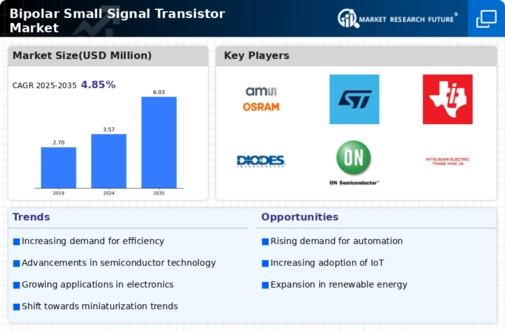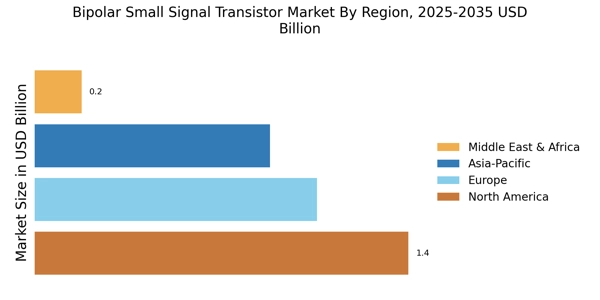Growth in Telecommunications Sector
The Bipolar Small Signal Transistor Market is significantly influenced by the expansion of the telecommunications sector. As the demand for high-speed internet and mobile connectivity escalates, the need for reliable and efficient signal amplification becomes paramount. The telecommunications industry is expected to grow at a compound annual growth rate (CAGR) of around 6% through 2025, which could lead to increased investments in infrastructure and technology. Bipolar small signal transistors play a crucial role in amplifying signals in various telecommunications applications, including base stations and repeaters. This growth in telecommunications is likely to drive the demand for bipolar small signal transistors, thereby enhancing the market's overall prospects.
Emergence of Internet of Things (IoT)
The Bipolar Small Signal Transistor Market is being shaped by the emergence of the Internet of Things (IoT). As more devices become interconnected, the need for efficient signal processing and amplification is becoming increasingly critical. The IoT market is anticipated to grow exponentially, with estimates suggesting it could reach over 1 trillion USD by 2025. This growth is likely to drive demand for bipolar small signal transistors, which are integral to the functioning of various IoT devices, including smart home appliances and industrial sensors. The ability of these transistors to operate effectively in low-power environments makes them particularly suitable for IoT applications, thereby enhancing their relevance in the market.
Advancements in Automotive Electronics
The Bipolar Small Signal Transistor Market is poised to benefit from advancements in automotive electronics. With the automotive sector increasingly integrating electronic systems for enhanced functionality, the demand for efficient signal processing components is on the rise. The automotive electronics market is projected to reach approximately 400 billion USD by 2025, driven by trends such as electric vehicles and advanced driver-assistance systems (ADAS). Bipolar small signal transistors are essential in these applications, providing reliable performance in signal amplification and processing. As automotive manufacturers continue to innovate, the Bipolar Small Signal Transistor Market is likely to see substantial growth, reflecting the broader trends in automotive technology.
Rising Demand for Consumer Electronics
The Bipolar Small Signal Transistor Market is experiencing a surge in demand driven by the proliferation of consumer electronics. Devices such as smartphones, tablets, and wearable technology increasingly rely on efficient signal processing, which bipolar small signal transistors facilitate. The market for consumer electronics is projected to reach approximately 1.5 trillion USD by 2025, indicating a robust growth trajectory. This demand is likely to propel the Bipolar Small Signal Transistor Market, as manufacturers seek to enhance performance and reduce power consumption in their products. Furthermore, the miniaturization of electronic components necessitates the use of compact and efficient transistors, further solidifying the role of bipolar small signal transistors in modern electronics.
Increased Focus on Renewable Energy Solutions
The Bipolar Small Signal Transistor Market is also influenced by the increased focus on renewable energy solutions. As countries strive to reduce carbon emissions and transition to sustainable energy sources, the demand for efficient electronic components in renewable energy systems is rising. The renewable energy market is projected to grow significantly, with investments expected to exceed 2 trillion USD by 2025. Bipolar small signal transistors are essential in various renewable energy applications, including solar inverters and wind turbine controllers, where they facilitate efficient signal processing. This trend towards sustainability is likely to bolster the Bipolar Small Signal Transistor Market, as manufacturers seek to develop components that align with environmental goals.
















Leave a Comment